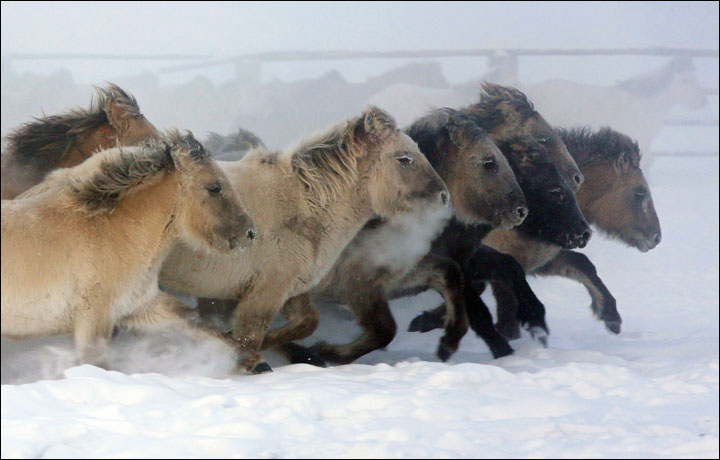
Posted on 11/29/2015 7:27:04 PM PST by TigerLikesRooster
Fast track evolution as great Siberian symbol is surprisingly unmasked as an immigrant breed.
Researchers say these horses, which seem so well attuned to the harsh cold with thick, dense winter coats, their armour against temperatures of minus 70C (minus 94F), are incomers that only arrived in these parts within the last 800 years. Picture: Maria Vasilyeva
The resilient Yakutian horses are one of the great native sights of the Sakha Republic - or Yakutia. In their way as much a part of the classic Siberian scenery as permafrost, extinct woolly mammoths, diamonds and Laika dogs in this kingdom of cold. Except that these horses are not really native.
Fascinating new scientific research has found that their seemingly built-in protection against extreme Arctic conditions is a recent phenomenon, at least by the normal tortoise-paced standards of evolution.
Researchers say these horses, which seem so well attuned to the harsh cold with thick, dense winter coats, their armour against temperatures of minus 70C (minus 94F), are incomers that only arrived in these parts within the last 800 years. Yet during that time, the requirement to survive has seen a quick-fire - almost overnight in relative terms - evolution by this species of horse.
Moreover, there was indeed a breed of horses native to this vast area of Russia, in which lie the coldest permanently inhabited communities on the planet. But these true native horses became extinct, at roughly the same time as the woolly mammoth and rhinoceros also died out, finally disappearing around 5,000 years ago.
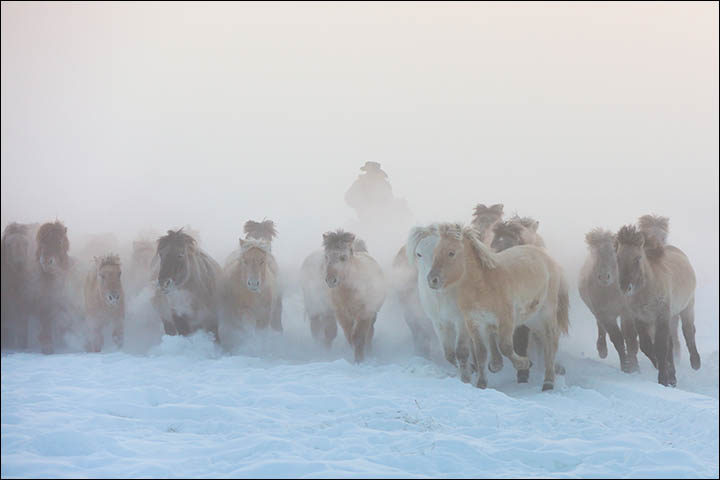
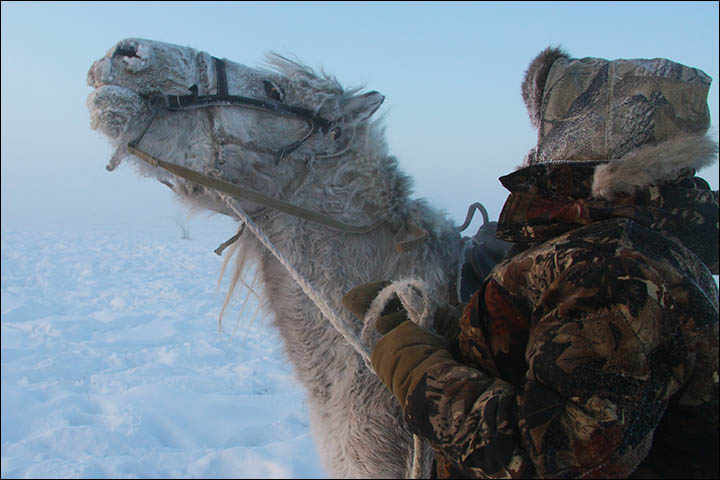
'This is truly amazing as it implies that all traits now seen in Yakutian horses are the product of very fast adaptive processes.' Pictures: Maria Vasilyeva
It transpires that a human population migrating within the last millennium to this land of ice - probably from Mongolia - brought horses with them, and these are the ancestors of today's distinctive Yakut horses, shown in our pictures.
'This is truly amazing as it implies that all traits now seen in Yakutian horses are the product of very fast adaptive processes, taking place in about 800 years,' explained Dr Ludovic Orlando, leader of an international team of scientists.
'This represents about 100 generations for horses. That shows how fast evolution can go when selective pressures for survival are as strong as in the extreme environment of Yakutia.'
The forebears of today's hardy horses are the domesticated stock of Mongolia, not the wild horses known to have roamed Yakutia in ancient times, a species that remains today only in fossil form. Yet these migrant horses were central to the lives of the population that settled in Yakutia: had these animals not coped with, and thrived on, the cold, these human societies would not have survived.
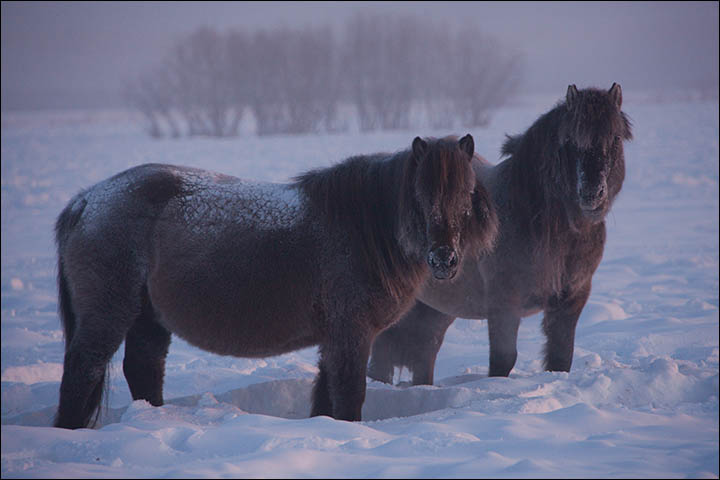
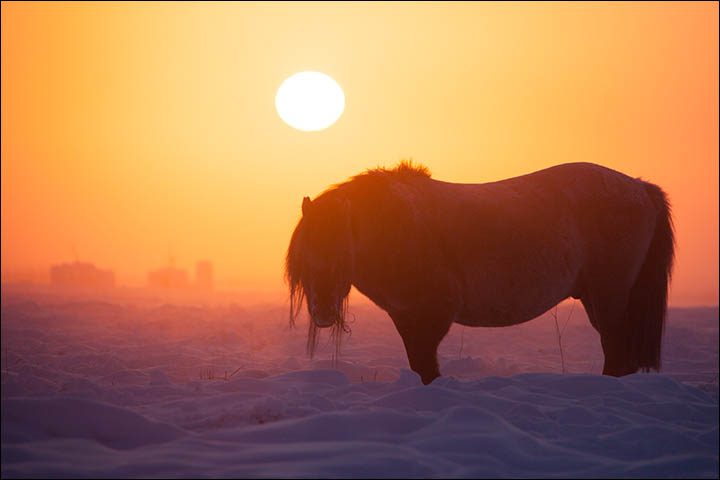
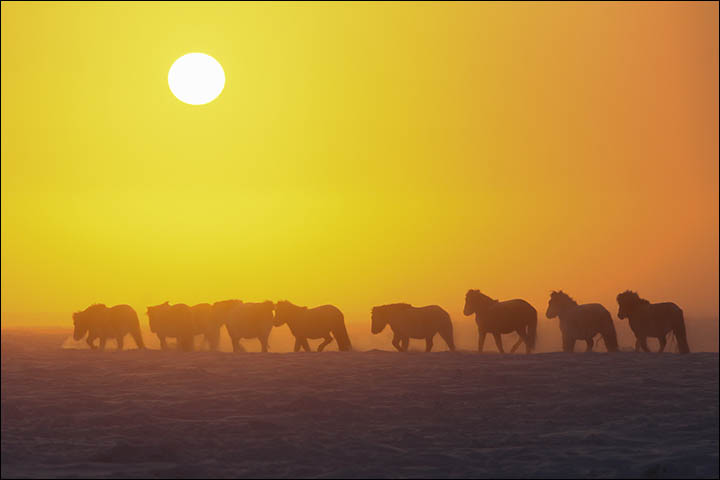
'In the genome of the Yakutian horses, we found the mutations that help the adaptation: revealed genes involved in the development of hair, affecting the body size, metabolic and hormonal signaling ways.' Pictures: Maria Vasilyeva
'We know now that the extinct population of wild horses survived in Yakutia until 5,200 years ago,' he said. 'It extended from the Taymir peninsula to Yakutia, and probably all across the entire Holarctic region. In Yakutia, it may have become extinct prior to the arrival of Yakut people and their horses. Judging from the genome data, modern Yakutian horses are no closer to the extinct population than is any other domesticated horse.'
The research pinpointed the genes responsible for this supersonic evolution, finding similarities with both indigenous Siberian people and even woolly mammoths. Among them TGM3, involved in hair development, which may be responsible for the Yakutian horse's distinctive shaggy look, a key to shielding them from cold living outside all year round. The adaptations, many of them regulatory, also involved vasoconstriction, body size, hormones, and metabolism.
Researcher Dr Pablo Librado said: 'In addition to unveiling their evolutionary origins, our approach helped narrow down the genetic basis of adaptations that are unique to Yakutian horses. In one word, their genetic makeup.
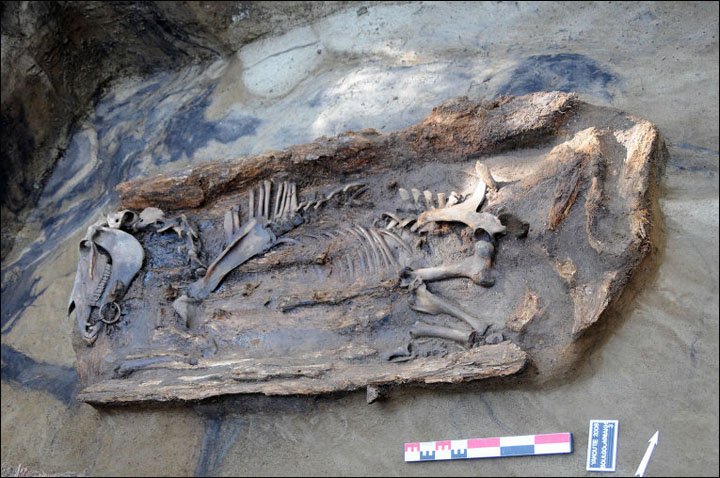
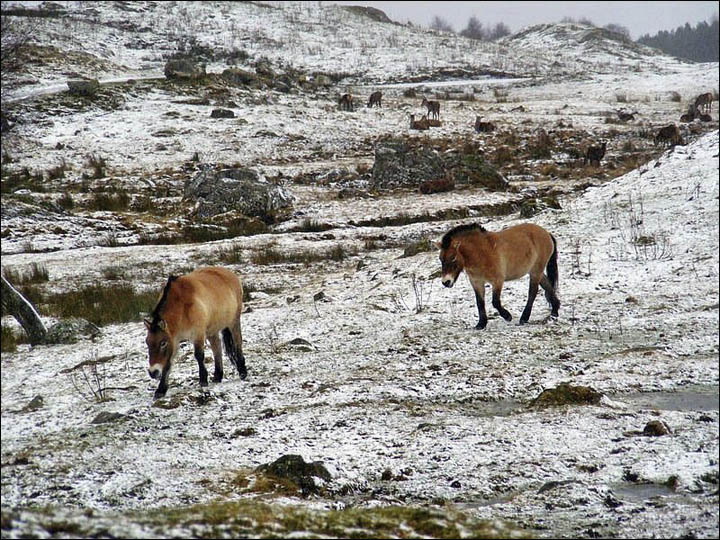
The geomes of modern-day horses and ancient horse samples from this region were compared to one another, and to existing sequences for dozens of domestic, still-wild Przewalski's, and ancient horses. Pictures: Patrice G/Proceedings of the National Academy of Sciences, floato
'We also found genes that were reported to have undergone selection in other Arctic populations, such as indigenous Siberian humans, and even the woolly mammoth. It provides a compelling example of evolutionary convergence, where unrelated groups exposed to similar environments end up independently developing similar adaptations.'
The research included genome sequencing on nine modern-day Yakutian horses, plus two ancient horse samples from this region, one from the early 19th century, and another 5,200 years old.
The genomes were then compared to one another, and to existing sequences for dozens of domestic, still-wild Przewalski's, and ancient horses. As for the earlier, extinct horses in this region, for example as seen in ancient remains on the Taymyr Peninsula, bore no close relationship to today's Yakutian horse population, and no more than to any modern breeds.
'The population from the Taymyr peninsula does not coincide with anything that paleontologists have ever described,' said Dr Orlando. This group is estimated to have diverged from the modern horse lineage around 160,000 years ago, the researchers estimate. They were as diverged from modern horses as humans are from Neanderthals, he said.
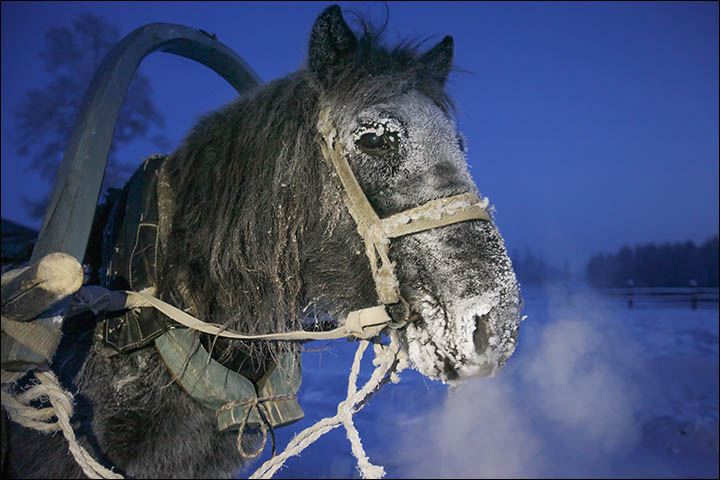
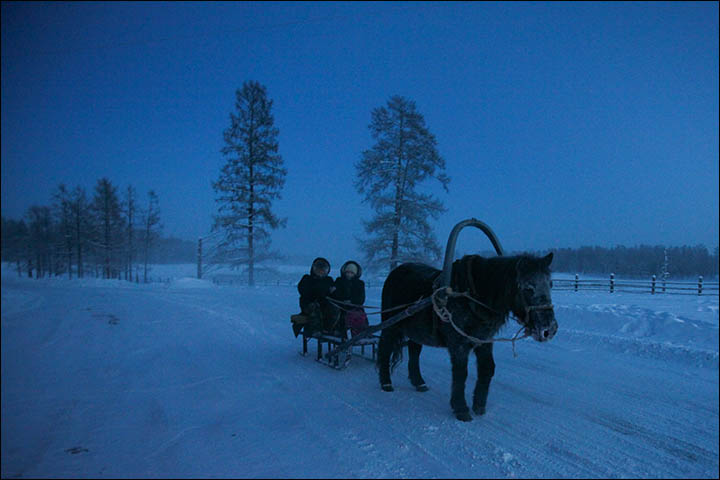
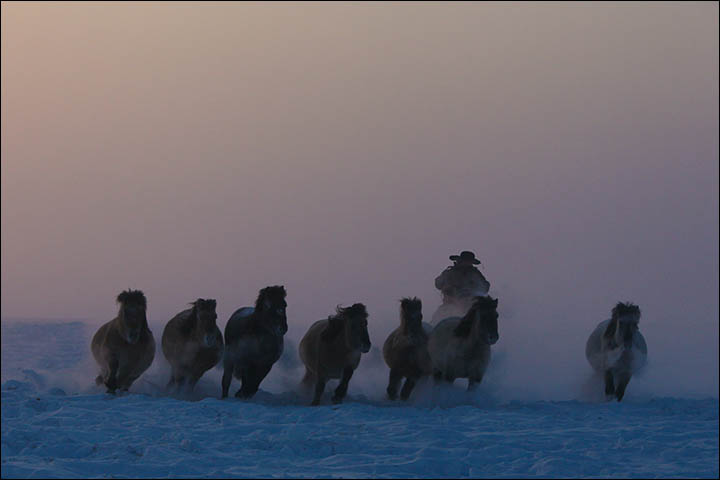
Yet these migrant horses were central to the lives of the population that settled in Yakutia: had these animals not coped with, and thrived on, the cold, these human societies would not have survived. Pictures: Maria Vasilyeva
Russian scientist Artem Nedoluzhko, head of the Laboratory of Bioinformatics and Genomics Research of Kurchatov Institute, in Moscow, who was involved in the research, said: 'We have shown that the Yakutian horse is one of the fastest cases of adaptation to the extreme Arctic temperatures.
'In the genome of the Yakutian horses, we found the mutations that help the adaptation: revealed genes involved in the development of hair, affecting the body size, metabolic and hormonal signaling ways. The changes found in the genome of Yakutian horses are an essential part of the adaptive genetic tools of the body.
'In addition, we found evidence of convergent evolution of the Yakutian horse with human populations that live in Siberia and mammoths, suggesting the existence of multiple evolutionary strategies needed to survive in extreme climatic conditions.'
Dr Orlando is from the Centre for GeoGenetics at the Natural History Museum of Denmark, part of the University of Copenhagen. Findings were published in the Proceedings of the National Academy of Sciences of the USA.
Yes! Being primitive does NOT mean being stupid.
Could you or I, with our sophisticated edumacations, survive a year in Siberia even if dropped in early spring?
They didn't. You would have to get horses that survived somewhat less harsh conditions further south, and keep importing horses north until you got some that were able to survive. Then repeat the process to get further north.
All I know is that the Mongolian Nomads did it, and they didn’t do it gradually over 800 years.
Thanks.
Definitely. Best time for those kinds of pictures are during the hottest, most humid part of the summer. :’)
Jack Hydrozine post #33: "Evolution is defined as increasing complexity of an organism through mutation.
When you switch a few genes off or on you aren’t adding any information therefore no evolution has occurred."
Jack Hydrozine post #35: "When you have no additional complexity added to an organism you can't call it evolution.
If you add more genes you add more complexity and then you can call it evolution."
Axenolith post #28: "There's no difference between humans culling out the ones less adapted to cold or the cold achieving it on its own..."
First of all the scientific definition of "biological evolution" (as opposed to, say, evolution of automobiles) is: 1) descent with modifications and 2) natural selection.
That's it, period.
For sake of discussion, we sometimes divide evolution into short-term "adaption" and long term "macro-evolution", but they are exactly the same process: every generation comes with small genetic mutations which are selected for, or against, based on more-or-less natural conditions.
These changes accumulate over time, eventually making it more & more difficult for separated populations of the same species to interbreed.
Based on the resulting degree of difficulties, biologists classify various populations as separated "breeds", "sub-species", "species", "genera", "families", etc.
As for witnessing "beneficial" new mutations, they can be seen whenever DNA from two populations are matched up and compared, allele by allele.
In human beings, we see them in natives of high Tibet & Andes compared to all others.
The high altitude dwellers have special DNA adaptions (Tibetans different from Andeans), not found in everybody else.
The same is true of some African adaptions to fight malaria, and European adaptions for lactose toleration in adults.
So the anti-evo claim of "no new genetic data" is falsified by comparisons of species DNA to find recent mutations.
Bottom line: there's no difference in processes between "adaption" and "evolution" short term, or long term.
Evolution = adaption = evolution = adaption = etc.
So if all life came from the primordial ooze how did the ooze “evolve”? Did it just adapt and not become more complex over time? Did it not add information to itself by some not-understood process or did it mutate?
When did the definition of evolution go from adding more information and creating more complexity in an organism to just simple adaptations where no information or complexity have been added?
Has evolution ever been directly observed?
Science recognizes a distinction between "complex chemistry" and "simple life", though where, exactly, that line should be drawn is a matter of discussion.
Prions which cause mad-cow disease are certainly organic chemistry, not biology.
Viruses: still chemistry, not life.
Bacteria: life.
But organic chemistry can and does evolve, and that is the basis for scientific hypotheses explaining how chemistry grew into life.
Jack Hydrazine: "Did it just adapt and not become more complex over time?
Did it not add information to itself by some not-understood process or did it mutate?"
Adaption = evolution, evolution = adaption.
Adaption / evolution can mutate from simple to complex, or complex to simple, depending on natural selection.
Yes, "complexification" is indeed an overall long-term effect of evolution / adaption, but in circumstances where complexity is a problem for survival, complexity is often eliminated.
For a quick example, think of: legs on whales.
Jack Hydrazine: "When did the definition of evolution go from adding more information and creating more complexity in an organism to just simple adaptations where no information or complexity have been added?"
But you have simply redefined evolution to fit your anti-evolution beliefs.
In fact, basic evolution theory, from the time of Darwin has consisted of two confirmed facts: 1) descent with modifications and 2) natural selection.
Yes, the results of evolution, including increased complexity, are often noted, but it's not inevitable, given that nature sometimes selects simplicity over complexity.
Jack Hydrazine: "Has evolution ever been directly observed?"
Evolution = adaption, adaption = evolution.
The fact of small mutations from parents to offspring have been observed, even in humans, over many generations.
The results of human or natural selection have been observed in many domesticated animals, and in wild animals subject to environmental changes.
The effects of evolution / adaption on DNA can be measured, allele by allele, in comparisons of different biological breeds, sub-species, species, genera & families, etc.
Bottom line: the parts of evolution / adaption which have been observed (i.e., mutations, natural selection) are facts, while that which cannot be observed (i.e., long term changes) is evolution theory.


Thanks BroJoeK.
This is a stupid article.
“Engineered adaptability” is the plausible explanation for this effect.
Disclaimer: Opinions posted on Free Republic are those of the individual posters and do not necessarily represent the opinion of Free Republic or its management. All materials posted herein are protected by copyright law and the exemption for fair use of copyrighted works.